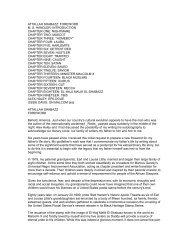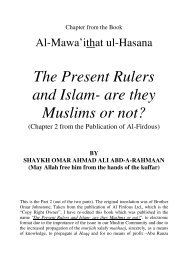Create successful ePaper yourself
Turn your PDF publications into a flip-book with our unique Google optimized e-Paper software.
his two nephews that of Frey, under which <strong>the</strong>y resided at<br />
Paris, where <strong>the</strong>y were guillotined in <strong>the</strong> days of Terror,<br />
We shall now explain <strong>the</strong> meaning of this fascinating<br />
footnote.<br />
According <strong>to</strong> legend, Abraham minted his own coins<br />
containing on one side a Hebrew inscription shown in <strong>the</strong><br />
footnote, which means "an old man, an old lady, a young man<br />
and a virgin."On <strong>the</strong> opposite side of <strong>the</strong> coin were <strong>the</strong> letters<br />
that were Hebrew name initials for those whom this epigram<br />
represented. They were, reading from right <strong>to</strong> left, "Abraham,<br />
Sarah, Isaac and Rebecca." On <strong>the</strong> coinage of <strong>the</strong> Frankists,<br />
<strong>the</strong> lettering similarly appeared, excepting that <strong>the</strong> letter Shin<br />
for Sarah which in Hebrew is designated by a dot on <strong>the</strong> left<br />
for an "s" sound had <strong>the</strong> dot on <strong>the</strong> right designating <strong>the</strong> "sh"<br />
sound, which s<strong>to</strong>od for Shabbetai. The Resh, which s<strong>to</strong>od for<br />
Rebecca, was replaced by <strong>the</strong> Hebrew letter Daleth (which<br />
bears some graphic resemblance <strong>to</strong> Resh) which s<strong>to</strong>od for<br />
Dobrushka.<br />
The names on <strong>the</strong> Frankist coin represented Elijah <strong>the</strong><br />
Prophet, Shabbetai, Rabbi Jonathan Eibeschutz (1690-1764),<br />
and Jacob Frank in <strong>the</strong> alias of Dobrushka. The latter two<br />
names require some fur<strong>the</strong>r explanation.<br />
Rabbi Jonathan Eibeschutz was a Frankist personality who<br />
led a double life. Secretly he was a Sabbatian, but outwardly<br />
he assumed <strong>the</strong> life of a great Rabbinical scholar and Decisor.<br />
It was <strong>the</strong> great Gaonic sage, Rabbi Jacob Emden (1697-<br />
1776), who exposed Eibeschutz as a Sabbatian. The basis for<br />
<strong>the</strong> expose began in 1751 after Rabbi Eibeschutz had left<br />
Metz in France in 1750 for Al<strong>to</strong>na in Germany. Emden based<br />
his charges on five amulets that had been issued <strong>to</strong> various<br />
individuals in <strong>the</strong> Metz community. 90 Certified copies of <strong>the</strong><br />
amulets were transmitted by scribes of <strong>the</strong> Jewish community<br />
and sealed by a royal notary. The amulets show that Eibeschutz<br />
invoked <strong>the</strong> power of Shabbetai Tzvi, and some bitter<br />
92




